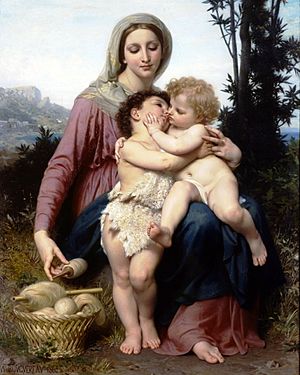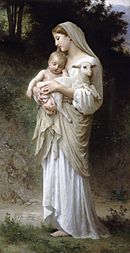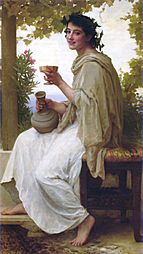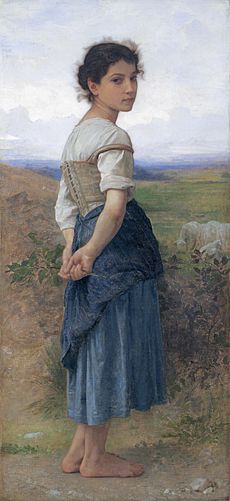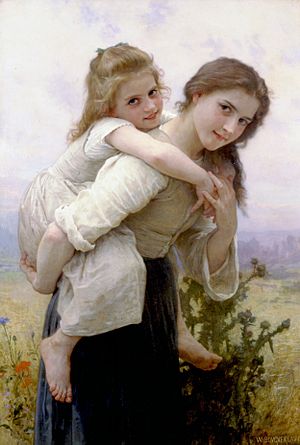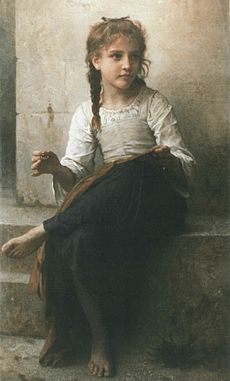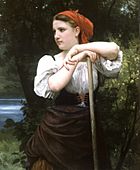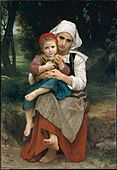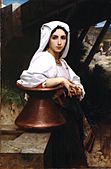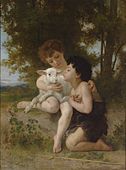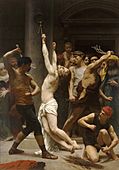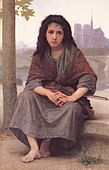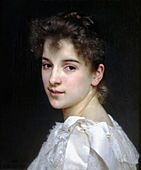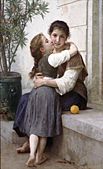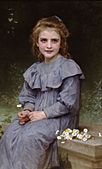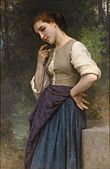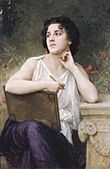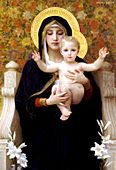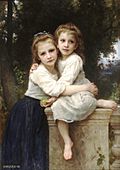William-Adolphe Bouguereau facts for kids
Quick facts for kids
William-Adolphe Bouguereau
|
|
|---|---|

Self-portrait (1879)
|
|
| Born | 30 November 1825 |
| Died | 19 August 1905 (aged 79) La Rochelle, French Third Republic
|
| Known for | Painter |
|
Notable work
|
|
| Movement | Realism, Academic Art |
| Spouse(s) |
Nelly Monchablon
(m. 1866; died 1877) |
William-Adolphe Bouguereau (born November 30, 1825 – died August 19, 1905) was a famous French academic painter. He created realistic paintings, often using stories from myths. He gave a modern twist to old classical ideas, focusing on the human body, especially women.
During his life, Bouguereau was very popular in France and the United States. He received many official awards and his paintings sold for high prices. He was known as the top "salon painter" of his time. However, artists like the Impressionists did not like his style.
By the early 1900s, people's tastes changed, and Bouguereau's art became less popular. But in the 1980s, people became interested in figure painting again. This led to a new appreciation for Bouguereau and his work. He painted 822 known artworks, but many of them are now missing.
Contents
Life and Painting Career
Early Life and Art Training
William-Adolphe Bouguereau was born in La Rochelle, France, on November 30, 1825. His family were merchants who sold wine and olive oil. William grew up as a Catholic.
When he was twelve, Bouguereau lived with his uncle Eugène, a priest. There, he learned to love nature, religion, and books. In 1839, he went to a Catholic college to study for the priesthood. He learned to draw and paint from Louis Sage, a student of the famous artist Ingres.
Later, Bouguereau moved to Bordeaux with his family. He joined the Municipal School of Drawing and Painting in 1841. He also worked in a shop, coloring pictures and making small paintings. He quickly became the best student in his class.
Bouguereau decided to become an artist in Paris. To earn money for the move, he painted 33 portraits in three months. In March 1846, at age twenty, he arrived in Paris.
He became a student at the École des Beaux-Arts, a famous art school. He also studied human anatomy, historical clothes, and old ruins. He learned academic painting from François-Édouard Picot. His painting Dante and Virgil in Hell (1850) was an early example of his classical style.
Academic painting valued historical and mythological subjects the most. Bouguereau wanted to win the Prix de Rome. This prize would give him three years to live and study at the Villa Medici in Rome, Italy. There, he could learn from the great Renaissance artists and see ancient Greek, Etruscan, and Roman art.
Studying in Rome: Villa Medici (1851–1854)
The young artist first tried to win the Prix de Rome in April 1848. There were riots in Paris soon after, and Bouguereau joined the National Guard. He tried again in 1849 and 1850, but did not win. Finally, in September 1850, he won a shared first prize for his painting Shepherds Find Zenobia on the Banks of the Araxes.
In January 1851, he arrived at the Villa Medici in Rome. Bouguereau explored the city, sketching and painting with watercolors. He also read classical books, which influenced his choice of subjects for the rest of his life. He traveled to Naples, Capri, Amalfi, and Pompeii.
He continued to work hard on his studies in Rome. He also explored more of Italy in 1852. He admired all traditional art, especially Greek sculpture. He also loved the works of Leonardo da Vinci, Raphael, Michelangelo, Titian, Rubens, and Delacroix. In April 1854, he left Rome and returned to La Rochelle.
Becoming a Famous Artist
Bouguereau continued to paint in the traditional academic style. He showed his art at the yearly Paris Salon exhibitions throughout his career. One early art critic said that Bouguereau was naturally good at drawing shapes. The critic praised him for following the style of ancient artists and those from the 1500s.
Raphael was one of Bouguereau's favorite artists. He took this review as a great compliment. He had even copied Raphael's The Triumph of Galatea as part of his Prix de Rome studies. In many of his paintings, Bouguereau used the same classical ideas for how he arranged his art, the shapes he used, and the subjects he chose. His elegant portraits of women were very popular. He could make a person look beautiful while still keeping their true likeness.
Although Bouguereau lived mostly in Paris, he often returned to his hometown of La Rochelle. People in La Rochelle respected him, and he received many art jobs from local citizens. From the early 1870s, he and his family spent every summer in La Rochelle. In 1882, he bought a house and farm buildings there. This became the family's summer home. He started many paintings there and finished them in his Paris studio.
Bouguereau's career really took off after his time at Villa Medici. In 1854–55, he decorated a relative's grand house in Angoulins. This included four large paintings showing the seasons. He took on other jobs to pay off his debts from Italy and help his mother. He decorated a mansion with nine large paintings of symbolic figures.
In 1856, the government asked him to paint Emperor Napoleon III Visiting the Victims of the Tarascon Flood. He also decorated a chapel at Saint-Clotilde. He received the Legion of Honour award on July 12, 1859. Around this time, Bouguereau started to paint fewer large historical scenes. Instead, he focused on more personal paintings with realistic and country themes.
By the late 1850s, he had good connections with art dealers, especially Paul Durand-Ruel. These dealers helped people buy paintings from artists who showed their work at the Salons. The Salons attracted over 300,000 visitors each year, which helped artists become well-known. By the 1860s, Bouguereau's fame reached England.
Three of his paintings were shown at the 1863 Salon. His painting Holy Family was bought by Napoleon III. He gave it to his wife, Empress Eugénie, who hung it in her palace apartment.
His painting Bather (1864) was a huge success at an exhibition in Ghent, Belgium. A museum bought it for a lot of money. At this time, William also worked on decorations for the Grand Théâtre in Bordeaux, which took four years. In 1875, he started working on a chapel ceiling in La Rochelle with assistants. He created six paintings on copper over the next six years.
In the summer of 1875, he began Pietà, one of his most important religious paintings. It was shown at the 1876 Salon. He painted it to honor his son Georges, who had passed away. In May 1878, the Paris Universal Exhibition opened to show French art. Bouguereau found and borrowed twelve of his paintings from their owners for the exhibition. This included his new work Nymphaeum.
Bouguereau was a strong traditional artist. His paintings of everyday life and mythological stories were modern versions of classical ideas. These included both ancient Greek and Roman myths, and Christian stories. His paintings showed an ideal world with goddesses, nymphs, bathers, shepherdesses, and madonnas. This style was very appealing to wealthy art buyers of that time.
Bouguereau used traditional ways to create his paintings. He made detailed pencil drawings and oil sketches first. His careful method resulted in beautiful and accurate human figures. His way of painting skin, hands, and feet was especially admired.
He received many jobs to decorate private homes and public buildings. This added to his fame. He sometimes painted in his own style, and other times matched the style of an existing group of artworks. He also made smaller versions of his public paintings to sell, like The Annunciation (1888). He was also a successful portrait painter, and many of his paintings of rich people are still privately owned.
Teaching at Académie Julian
From the 1860s, Bouguereau was very involved with the Académie Julian. He taught and advised art students from all over the world, both male and female. For many decades, he taught drawing and painting to thousands of students. Many of them became successful artists in their own countries. Some followed his academic style, while others, like Henri Matisse, chose different paths. He later married his most famous student, Elizabeth Jane Gardner, after his first wife passed away.
Bouguereau received many awards from the Academy. He became a Life Member in 1876 and received the Grand Medal of Honour in 1885. He was made a Commander of the Legion of Honor in 1885 and a Grand Officier of the Legion of Honour in 1905. He started teaching drawing at the Académie Julian in 1875. This was an art school open to both men and women, separate from the École des Beaux-Arts. It had no entrance exams and low fees.
Family Life
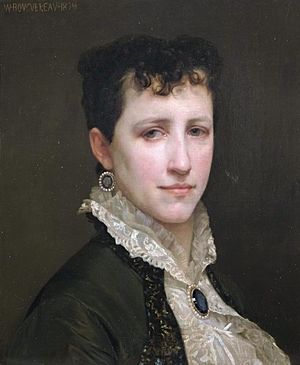
In 1856, William started living with Nelly Monchablon, one of his models. She was 19 years old. Their first child, Henriette, was born in April 1857. Their son Georges was born in January 1859. Their third child, Jeanne, was born in December 1861. William and Nelly quietly married on May 24, 1866. Eight days later, Jeanne died from a lung illness. In their sadness, the couple went to La Rochelle. Bouguereau painted a picture of Jeanne in 1868.
Their fourth child, Adolphe (called Paul), was born in October 1868. When Georges was 15, his health became poor. His mother took him away from the city air, but he died on June 19, 1875. Nelly had a fifth child, Maurice, in 1876. However, her health was getting worse, and doctors thought she had the same lung illness. She died on April 3, 1877, and baby Maurice died two months later.
The artist wanted to marry Elizabeth Jane Gardner, a student he had known for ten years. But his mother did not approve. After Nelly's death, his mother made him promise not to remarry while she was alive. After his mother passed away, and after being engaged for nineteen years, he and Gardner married in Paris in June 1896. His wife continued to work as his private secretary and helped manage their home.
His son Paul became sick in early 1899. Paul, his stepmother, and Bouguereau went to Menton in the south of France. When their stay was longer than planned, the artist found a room where he could paint. Paul died at his father's house in April 1900, at age 32. Bouguereau had outlived four of his five children; only Henriette lived longer than him. Elizabeth, who was with her husband until the end, died in Paris in January 1922.
His Homes
When Bouguereau arrived in Paris in March 1846, he stayed at the Hotel Corneille. In 1855, after his time in Rome, he lived at 27 rue de Fleurus. The next year, he rented a studio on the fourth floor at 3 rue Carnot, close to his apartment.
In 1866, the year he married Nelly, he bought a large piece of land on the rue Notre-Dame-des-Champs. He hired an architect to design a grand house with a studio on the top floor. The family moved in during 1868. Five servants lived with them, and his mother, Adeline, visited daily. Bouguereau lived here and in La Rochelle for the rest of his life.
Later Years and Passing
Bouguereau was a very hardworking painter. He often finished twenty or more paintings in a single year. Even in his later years, he would wake up at dawn to paint six days a week. He would continue painting until nightfall. Throughout his life, he is known to have painted at least 822 artworks. Many of these paintings are now lost.
Near the end of his life, he spoke about his love for art. He said, "Each day I go to my studio full of joy; in the evening when obliged to stop because of darkness I can scarcely wait for the next morning to come ... if I cannot give myself to my dear painting I am miserable."
In the spring of 1905, Bouguereau's house and studio in Paris were robbed. On August 19, 1905, at age 79, Bouguereau died in La Rochelle from heart disease. There was much sadness in his hometown. After a church service at the cathedral, his body was taken by train to Paris for a second ceremony. Bouguereau was buried with Nelly and his children in the family tomb at Montparnasse Cemetery.
Notable Works
- Depictions of women in classical themes
- Depictions of women
His Reputation as an Artist
During his time, many in the academic art world thought Bouguereau was one of the greatest painters. At the same time, artists who were trying new styles, like the avant-garde, did not like his work. He also became very famous in countries like Belgium, the Netherlands, Portugal, Spain, Italy, Romania, and the United States. His paintings sold for very high prices. Often, his works were bought just days after he finished them. Some were even bought by international collectors before they were complete.
Bouguereau's career was almost always successful. For many, he represented good taste and respect for old traditions. For others, he was a skilled artist who was stuck in the past. Artists like Degas used the term "Bouguereauté" to describe art that looked too smooth and artificial.
American millionaires eagerly bought Bouguereau's paintings. They saw him as the most important French artist of that time. For example, Nymphs and Satyr was bought by John Wolfe, then by Catharine Lorillard Wolfe, and later by hotel owner Edward Stokes. He displayed it in New York City's Hoffman House Hotel. Two of Bouguereau's paintings in Leland Stanford's mansion in Nob Hill were lost in the San Francisco earthquake and fire of 1906.
However, even when he was alive, some critics disagreed about his art. Art historian Richard Muther wrote in 1894 that Bouguereau lacked artistic feeling. In 1926, American art historian Frank Jewett Mather criticized Bouguereau's work for being too focused on making money. Bouguereau himself said in 1891 that his later work was largely shaped by what people wanted to buy. He explained, "What do you expect, you have to follow public taste, and the public only buys what it likes. That's why, with time, I changed my way of painting."
Bouguereau's popularity declined after 1920, partly because people's tastes changed. Comparing his work to that of his Realist and Impressionist friends, Kenneth Clark said Bouguereau's paintings were too smooth and shiny, like wax.
In 1974, the New York Cultural Center held a show of Bouguereau's work. This helped bring attention back to his art. In 1984, the Borghi Gallery held a show of 23 oil paintings and one drawing. In the same year, a major exhibition was organized by the Montreal Museum of Fine Arts in Canada. This exhibition traveled to Paris and Hartford before ending in Montréal. More recently, American collector Fred Ross has helped bring back interest in the artist. He owns many of Bouguereau's paintings and features him on his website, Art Renewal Center.
In 2019, the Milwaukee Art Museum gathered over 40 of Bouguereau's paintings for a big show. The Wall Street Journal said this show asked people to "see Bouguereau through the eyes of an age when he was lionized, and Impressionism was dismissed as 'French freedom.'" The exhibition was also planned to go to the Memphis Brooks Museum of Art and the San Diego Museum of Art.
Prices for Bouguereau's paintings have steadily gone up since 1975. Major paintings have sold for high prices: $1,500,000 in 1998 for The Heart's Awakening, $2,600,000 in 1999 for The Motherland, and Charity at auction in May 2000 for $3,500,000. Bouguereau's works are now in many public art collections.
Notre Dame des Anges ("Our Lady of the Angels") was last shown publicly in the United States at the World's Columbian Exhibition in Chicago in 1893. In 2002, it was given to the Daughters of Mary Mother of Our Savior, a group of nuns. In 2009, the nuns sold it for $450,000 to an art dealer, who then sold it for over $2 million.
His Name
His full name is sometimes written as William-Adolphe Bouguereau or William Adolphe Bouguereau. Other times, it appears as Adolphe William Bouguereau. However, he usually signed his artworks simply as William Bouguereau, or more often as "W.Bouguereau.date" (using the French alphabet) and later as "W-BOVGVEREAV-date" (using the Latin alphabet).
Awards and Honours
- 1848: Second Prix de Rome, for Saint Pierre après sa délivrance de prison, vient retrouver les fidèles chez Marie.
- 1850: Premier Prix de Rome, for Zenobie retrouvée par les bergers sur les bords de l'Araxe.
- 1859: Knight of the Legion of Honour
- 1876: Officer of the Legion of Honour
- 1881: Knight in the Order of Leopold
- 1885: Commander of the Legion of Honour
- 1885: Grand Medal of Honour
- 1890: Member of the Royal Academy of Science, Letters and Fine Arts of Belgium
- 1905: Grand Officier of the Legion of Honour
In Books and Stories
- In The King in Yellow by Robert W. Chambers, Bouguereau is mentioned as a teacher at the École des Beaux-Arts.
- In Sir Arthur Conan Doyle's novel The Sign of the Four (1890), a character named Mr. Sholto says, "there cannot be the least question about the Bouguereau. I am partial to the modern French school."
Selected Paintings
- La Danse (1856)
- Bather (1864)
- Far From Home (1867)
- Alone in the World (Latest 1867)
- The Knitting Girl (1869)
- The Elder Sister (1869)
- Italian Girl at the Fountain (1870)
- Baigneuse (1870)
- Nymphs and Satyr (1873)
- Homer and his Guide (1874)
- At the Edge of the River (1875)
- Flora and Zephyr (1875)
- The Grape Picker (1875)
- The Little Knitter (1875)
- La Jeunesse et l'Amour (1877)
- The Donkey Ride (1878)
- The Birth of Venus (1879)
- Girl Defending herself against Cupid (1880)
- Song of the Angels (1881)
- Evening Mood (1882)
- The Nut Gatherers (1882)
- Alma Parens of Mother France (1883)
- The Youth of Bacchus (1884)
- Biblis (1884)
- The Return of Spring (1886)
- Woman with Captive Cupid (1886)
- The First Mourning (1888)
- The Shepherdess (1889)
- Les murmures de l'Amour (1889)
- Gabrielle Cot, a portrait of Cot's daughter, 1890
- L'Amour et Psyché, enfants (1890)
- The Bohemian (1890)
- Little Beggars (1890)
- Le Travail interrompu (1891)
- The Goose Girl (1891)
- The Wasps Nest (1892)
- Innocence (1893)
- Pleasant Burden (1895)
- The Ravishment of Psyche (1895)
- The Wave (1896)
- Admiration (1897)
- La Vierge au lys (1899)
- Rêve de printemps (1901)
- Yvonne on the Doorstep (1901)
- The Oreads (1902)
- Oceanid (1904)
- In The Woods (1905)
- Source
Gallery
-
Gabrielle Cot, daughter of Pierre Auguste Cot (1890)
See also
 In Spanish: William-Adolphe Bouguereau para niños
In Spanish: William-Adolphe Bouguereau para niños
- Gustave Doyen
- Sir Lawrence Alma-Tadema


